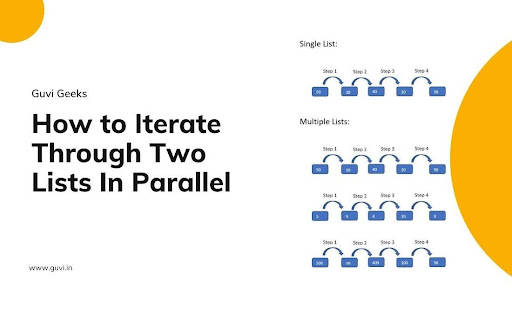
Python: How To Iterate Through Two Lists In Parallel?
Sep 06, 2024 3 Min Read 1657 Views
(Last Updated)
If you are quite familiar with Python programming, then you sure might be knowing that a list in Python can store multiple elements within a single variable. But wait!! Do you know How To Iterate Through Two Lists In Parallel?
Well, it might be tricky for some Python users and for Python beginners.
But not anymore! We are here with a complete guide that will help you know How To Iterate Through Two Lists In Parallel.

If you dig down the foundations of Python, you will notice that list is one of the four in-built data types (besides Set, Tuple, and Dictionary) available in Python. Moreover, the list is used for storing the collection of similar or dissimilar data.
Key point: A list can be created using the square brackets [ ] and elements separate using the commas. And, a list can have other lists as an element and it is known as a nested list.
Therefore, we can say that list is one of the useful in-built data types of Python. Now, let’s move to know the methods for How To Iterate Through Two Lists In Parallel.
Table of contents
- How to iterate through two lists in parallel?
- Let's take an example to execute zip() and itertools.izip():
- Let's take an example of itertools.zip_longest()
- Let an example of izip_longest()
- Python 2:
- Let's understand 'how to iterate through two lists in parallel?' with an example:
- Wrapping it up!!!
- Get started here with MCQ's
How to iterate through two lists in parallel?
The list can store a collection of elements. It is always easy to execute a single element of a single list. But when it comes to iterating the multiple lists parallelly, it might be a little bit confusing!
Well, there are two different methods for how to iterate through two lists in parallel. Let’s check both of them one by one with relevant examples.
Below, we have taken the example of a 3 element list that helps you understand in a better way.
- zip(): zip() function returns the iterator in Python 3. It stops running when any of the list elements get exhausted. Or we can say that it always executes till the list’s smallest elements come.
Before diving into the next section, ensure you’re solid on Python essentials from basics to advanced-level. If you are looking for a detailed Python career program, you can join GUVI’s Python Career Program with placement assistance. You will be able to master the Multiple Exceptions, classes, OOPS concepts, dictionary, and many more, and build real-life projects.
Also, if you would like to explore Python through a Self-paced course, try GUVI’s Python Self-Paced course.
Let’s take an example to execute zip() and itertools.izip():
Python 3:
Output:
(‘white’, 1, 365)
(‘red’, 2, 366)
- itertools.zip_longest(): It does not stop after executing the smallest element of the list. zip_longest execute till each element of the list does not get ran. In case there is a short iterator(s), this function results in a tuple as the None value.
Let’s take an example of itertools.zip_longest()
Python 3:
Output:
(‘white’, 1, 365)
(‘red’, 2, 366)
(‘blue’, 3, None)
NOTE:
If you want to assign a specific value rather than None in zip_longest() or izip_longest(), then you can assign it as:
Let an example of izip_longest()
Python 2:
Output:
(‘white’, 1, 365)
(‘red’, 2, 366)
(‘blue’, 3, 0)
This is How To Iterate Through Two Lists In Parallel in Python.
Bonus Point:
Python 2.x has two different functions, izip_longest() and izip() (both functions are not available in Python 3.x). These functions are used for returning the iterator (in Python 3.x zip_longest() and zip() are used for returning the iterator).
Let’s understand ‘how to iterate through two lists in parallel?’ with an example:
Output:
(1, 4)
(2, 5)
(3, 6)
(7, 9)
(8, 8)
(9, 7)
| Key Point: Does it mean zip_longest() and zip() do not have any use in Python 2.x? No, not at all!! The zip_longest() and zip() are used for returning the list in Python 2.x. |
Kickstart your Programming journey by enrolling in GUVI’s Python Career Program where you will master technologies like multiple exceptions, classes, OOPS concepts, dictionaries, and many more, and build real-life projects.
Alternatively, if you would like to explore Python through a Self-Paced course, try GUVI’s Python Self Paced course.
Wrapping it up!!!
How To Iterate Through Two Lists In Parallel might be a difficult question for you. But using the above-mentioned methods it would become quite easy to get the answer to your question. We recommend you to practice the above example on your own for better understanding.
But if you still have any issue with the list in Python concept, let us know about it. You can comment on your query in the comment section. We will guide you with the best solution at the earliest. So, jot down your queries and let us know. You may drop us your contact in the form below so that we can give you a call and answer your queries.
“Keep learning and keep polishing your Python skills with GUVI.”
Let’s test your knowledge on “how to iterate through two lists in parallel?“
Get started here with MCQ’s
- What will be the output of the following code:
import itertools
list1=[3,5,7]
list2=[-3,-5,8]
for i in zip(list1, list2):
print(i)
(A)
3 5 7
-3 -5 8
(B)
(3, -3)
(5, -5)
(7, 8)
(C) Error
(D) None of the above
| Correct Answer: (B) The zip will execute the list simultaneously and put the result in i. |
- What will be the output of the following code:
import itertools
list1=[5, 10, 15]
list2=[-5, -10, -15]
list3=[x+y for x, y in zip(list1, list2)]
print(list3)
(A) [0, 0, 0]
(B) [10, 20, 30]
(C) Error
(D) None of the above
| Correct Answer: (A) Here, x and y are the list1 and list2 respectively. The list consists of the result of x + y that is [5+(-5), 10+(-10), 15+(-15)] => [0, 0, 0]. |
- Is the statement TRUE or FALSE?
Zip() runs only till the smallest of each list gets executed.
(A) True
(B) False
| Correct Answer: (A) this statement is true as zip always runs till only the smallest element of the list gets executed. |
- Fill in the blank.
In Python2.x, zip_longest() and zip() use to return ________, whereas izip_longest() and izip() use to return __________.
(A) iterator, list
(b) iterator
(c) list
(D) list, iterator
| Correct Answer: (D) Python 2.x has two functions (izip_longest() and izip()) for returning iterators. |
- What will be the output of the following code:
import itertools
list1=[1,2,3]
list2=[4,5,6]
list3=[7,8]
for a, b, c in zip(list1, list2, list3):
print(a, b, c)
(A)
(1, 4, 7)
(2, 5, 8)
(B)
(1, 4, 7)
(2, 5, 8)
(7, 8, 0)
(C) Error
(D) None of the above
| Correct Answer: (A) because zip always runs till only the smallest element of the list gets executed. |


































Did you enjoy this article?